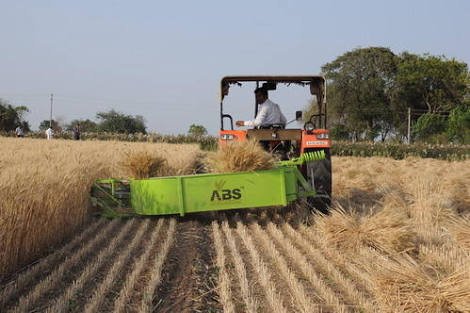.jpeg)
source
Harvesting machinery is for the most part classified by crop:reapers for cutting cereal grains and threshers for isolating the seed from the plant. The more current consolidate cuts, sifts, and cleans the grain in one task. Corn (maize) harvesting is performed by mechanical corn pickers that snap the ears from the stalk with the goal that exclusive the grain and cobs are harvested. Corn shelling might be done mechanically in the field, after or with picking. Stripper-type cotton reapers, which strip the whole plant of both open and unopened bolls, work best late in the season after ice has slaughtered the green vegetative development. Roughage and rummage machines incorporate trimmers, crushers, windrowers, field choppers, balers, and a few machines that press the feed into wafers or pellets.
Grass, vegetables, corn (maize), and different crops are frequently put into storehouses to keep them in a succulent and aged state as opposed to put away dry as roughage. To make silage, the crops must be sliced up to allow tight pressing in the storehouse, delivering anaerobic maturation and forestalling arrangement of shape. All silage crops are cut in the field with a scrounge collector that cuts and cleaves the crop promptly or grabs and slashes a windrow that has been cut and raked before.
.jpeg)
source
Root crops are harvested with diggers and digger-pickers, which regularly pull up blocks, stones, and vines with the crop. In spite of the fact that a few machines convey specialists who physically deal with incidental material, this errand is progressively being performed mechanically. Present day sugar-beet reapers lift the entire root starting from the earliest stage, the earth from it, and convey it to a canister or wagon. Now and then the beet tops are expelled before reap of the roots and utilized for steers feed. Peanuts (groundnuts) are lifted, vines and all, and permitted to dry before expulsion of the pods.
Tobacco-harvesting helps might be grouped in three vital courses, as indicated by the harvesting and relieving techniques utilized, which rely upon the sort of tobacco and its utilization. Vent relieved tobacco, a substantial plant that may stand three to four feet (90 to 120 centimeters) high, is harvested with machines that convey a few specialists who ride the lower stages of the machines, cut the leaves, and place them on transport lines, where the leaves are tied mechanically or by hand. Burley tobacco has typically been harvested by specialists utilizing a cleaver compose cut. In the wake of cutting, the extensive end of the stalk is settled onto the honed end of a stick, which—when stacked with various stalks—is hung by deliver a tobacco horse shelter for relieving. Scientists are endeavoring to motorize the cutting, skewering, and hanging of burley tobacco. Little has been done, in any case, around the automation of the harvesting of the little fragrant tobacco leaves, which are developed in the shade, picked by hand, tied with a string, at that point hung for relieving.
.jpeg)
source
Tree-crop harvesting is expert by hand or with mechanical shakers. Vegetable crops, for example, asparagus, lettuce, and cabbage are still harvested to a great extent by hand, however shortage and staggering expense of field work has prompted some automation around there, quite with tomatoes.
Crop-processing machinery
Machinery is broadly used to get ready crops for transportation, for safe stockpiling, for the market, and for sustaining to domesticated animals. Advances in such machines have been quick, especially with new crops, expanded yields, various crop hones, and evolving procedures.
In the most well-known strategy for crop drying, the crop, typically grain, is spread on floors or tangles and blended habitually while presented to the sun. Such frameworks, however greatly regular in the developing nations, are moderate and subject to the climate. Constrained air-drying frameworks permit the farmers considerably more opportunity in picking grain assortments and collect time. Genuinely straightforward in task, these methods have been picking up prevalence in the tropics. Warmth is frequently added to expand air temperatures amid the drying time frame.
In a procedure called dryeration, wet corn (maize) is set in a bunch or nonstop dryer. In the wake of losing 10 to 12 percent of its dampness, the hot corn is exchanged to the dryeration cooling receptacle, in which it is tempered for six to 10 hours and after that gradually cooled by ventilation for 10 hours. This procedure decreases piece harm and expands dryer yield.
High dampness in put away feed not just purposes fast crumbling of its incentive as feed however regularly brings about sudden ignition. At the point when roughage is first cut, it generally contains 70 percent or more dampness. It withers and rapidly dries to a dampness substance of around 40 percent. At this stage, it can be dried to a sheltered stockpiling condition, around 15 percent dampness, by blowing air through it, at times with supplemental warmth.
Feed-processing plants, regularly alluded to as feed processors, are utilized primarily to mill grains for domesticated animals feed, which helps assimilation. The ground material is generally genuinely coarse and on occasion may just be squashed. Present day processes every now and again are intended to enable the rancher to pound the grain and to blend in different fixings in wanted amounts.
Different kinds of crop-processing machinery incorporate machines that different attractive seed from weed seed, stems and leaves, and earth; reviewing machinery to characterize seed by width, length, or thickness; natural product graders and separators; and cotton gins, which isolate cotton seeds from the strands.
.jpeg)
Beautifully crafted publication, thanks for sharing
Resteem
(to be a part of this community; ensure to always use #farms and #steemchurch for agricultural related post)
SteemChurch Farm ( @FARMS)